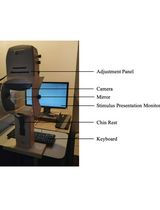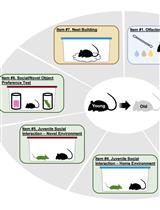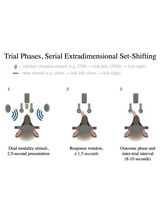- EN - English
- CN - 中文
Measuring Heart Rate in Freely Moving Mice
测量行为小鼠的心率
(*contributed equally to this work) 发布: 2024年02月05日第14卷第3期 DOI: 10.21769/BioProtoc.4926 浏览次数: 2657
评审: Xi FengAnonymous reviewer(s)
Abstract
Measuring autonomic parameters like heart rate in behaving mice is not only a standard procedure in cardiovascular research but is applied in many other interdisciplinary research fields. With an electrocardiogram (ECG), the heart rate can be measured by deriving the electrical potential between subcutaneously implanted wires across the chest. This is an inexpensive and easy-to-implement technique and particularly suited for repeated recordings of up to eight weeks. This protocol describes a step-by-step guide for manufacturing the needed equipment, performing the surgical procedure of electrode implantation, and processing of acquired data, yielding accurate and reliable detection of heartbeats and calculation of heart rate (HR). We provide MATLAB graphical user interface (GUI)–based tools to extract and start processing the acquired data without a lot of coding knowledge. Finally, based on an example of a data set acquired in the context of defensive reactions, we discuss the potential and pitfalls in analyzing HR data.
Key features
• Next to surgical steps, the protocol provides a detailed description of manufacturing custom-made ECG connectors and a shielded, light-weight patch cable.
• Suitable for recordings in which signal quality is challenged by ambient noise or noise from other recording devices.
• Described for 2-channel differential recording but easily expandable to record from more channels.
• Includes a summary of potential analysis methods and a discussion on the interpretation of HR dynamics in the case study of fear states.
Background
Over the past decades, measurements of cardiac function have been exploited not only in cardiovascular research but also in other disciplines like neuroscience due to their tight connection with neural processes and as readouts for emotional states (Carrive, 2000; Leman et al., 2003; Tovote et al., 2005; Stiedl et al., 2009). To take into account the integrated nature of cardiac and motor functions during emotional challenge, we recently developed a novel analytical framework. By analyzing cardiac parameters together with behavioral readouts, we unveiled critical cardio-behavioral states that would not have been detectable with either of the readouts alone (Signoret-Genest et al., 2023).
A variety of non-invasive and invasive methods have been established in order to measure cardiovascular parameters. Non-invasive approaches include surface recording (different electrodes are embedded in the floor and contacted by the individual paws) or external telemetry systems with instrumented jackets, which allow for simultaneous respiratory function monitoring (Chu et al., 2001; Sato, 2019; Fares et al., 2022). However, the signals acquired with these methods are prone to be noisy, compromising the final data quality, and the restricted experimental conditions (e.g., specific testing box) or added burden on the animal (jacket) might hinder the expression of naturalistic behaviors, thereby limiting their scope of application.
An electrocardiogram (ECG) records the electrical charge shifts that occur during a cardiac cycle. Non-tethered telemetry recording systems that record the ECG allow the animal to move freely and are thus ideally suited for long-term recordings (Calvet and Seebeck, 2023). However, they are both invasive, since they require a battery and components for wireless transmission, as well as rather expensive, and may additionally pose data synchronization challenges. On the other hand, tethered systems to record the ECG are inexpensive and easy to establish but must be optimized in order to successfully deal with potential hurdles such as environmental interferences or experimental artifacts.
Tethered ECG recordings, in particular, grant researchers direct access to raw data, which must then undergo proper pre-processing to extract the relevant biological phenomenon, namely heartbeats. As for any other technique, heart rate data then needs to be processed to answer biological questions. However, despite the apparent ubiquity of this readout, the selection of analyses, data sub-selection, treatment, and interpretation are not immune to pitfalls and must be approached with caution.
Here, we present a protocol for cost-effective, highly reliable, and user-friendly ECG recordings in freely behaving mice. The protocol encompasses the fabrication of the patch cable and ECG connector implants, detailed surgical implantation procedures, and subsequent data acquisition and processing steps. We also provide access to a custom graphical user interface (GUI) for heart rate extraction, along with specific (pre)processing strategies. We discuss data processing and interpretation through the scope of recent data, showing that there is more to heart rate–related readouts than simple averages or single heart rate variability (HRV) values, and that such minimalist processing could reduce the statistical power of studies or introduce biases.
Materials and reagents
Reagents
Orthophosphoric acid (Carl Roth, catalog number: 6366.1)
Paladur, liquid component (Anton Gerl, catalog number: 82462)
Buprenorphin (Bayer, catalog number: 14439113)
Isoflurane (cp-pharma, catalog number: 1214)
Depilatory cream (Veet)
Cutasept F (Hartmann AG, catalog number: 9803650)
Naropin (Aspen Germany, catalog number: 02749854)
Vitagel (Bausch & Lomb, catalog number: 1318187)
Braunol (Braun, catalog number: 190971)
Metacam (Boehringer Ingelheim, catalog number: 08890217)
Laboratory supplies
Circular miniature connector, male (OMNETICS, catalog number: A79108-001)
Wire, stainless steel, 7 strand, PFA (AM Systems, catalog number: 793200)
Soldering tin (Stannol, catalog number: 574006)
Glue, transparent (Silisto, catalog number: 71024)
Ultra-flexible microminiature shielded cable (Daburn, catalog number: 2721/5)
Blunt needles, 27 G (Braun Petzold, catalog number: 9180117)
M9 connector, male (Binder, catalog number: 99-0413-00-05)
Heat shrink tubing set (Haupa, catalog number: 267200)
Regular insulated wire (RadioSpare, catalog number: 872-5167)
Circular miniature connector, female (OMNETICS, catalog number: A79109)
Teflon tape (Toolineo, catalog number: 100000000178797)
Aluminum foil
1 mL syringes (Praxisdienst, catalog number: 138322)
Needles, 30 G (Praxisdienst, catalog number: 128330)
Cotton buds
Cotton wipes (Maicell, catalog number: 72100)
Glue, viscous (Pattex, catalog number: 2804443)
Scalpel blade (Hartenstein, catalog number: SJ10)
Suture material, ECG (Serag Wiessner, catalog number: LO07340B)
Suture material, skin, braided silk (SMI, catalog number: 8200518)
Toothpicks
Glue, black (Wekem, catalog number: WK-2400)
Equipment
Third hand (Toolcraft, catalog number: TO-6871371)
Stereomicroscope (Olympus, model: SZ-61)
Forceps, straight (Fine Science Tools, catalog number: 11252-00)
Soldering station (Velleman, model: VTSSC40N)
Scissors (Passau Impex, catalog number: 14060-10)
Cable stripper (Toolcraft, catalog number: TO-4861971)
Lighter
Multimeter (Fluke, model: 179)
Balance (Kern, model: EMB 2200-0)
Anesthetizing box (Hugo Sachs Elektronik, catalog number: 50-0108)
Anesthesia mask (Hugo Sachs Elektronik, catalog number: 73-4858)
Anesthetic vaporizer (Hugo Sachs Elektronik, catalog number: 34-2052)
MiniVac gas evacuation unit (Hugo Sachs Elektronik, catalog number: 73-4910)
Fluosorber filter canister (Hugo Sachs Elektronik, catalog number: 34-0415)
Heating pad (Kent Scientific, model: RightTemp Jr.)
Forceps, curved (Fine Science Tools, catalog number: 11271-30)
Forceps, straight, blunt (Fine Science Tools, catalog number: 11002-14)
Feeding cannula (Fine Science Tools, catalog number: 18061-75)
Needle holder (Passau Impex, catalog number: T220218)
Scalpel handle (Fine Science Tools, catalog number: 10003-12)
Infrared lamp (Medisana, catalog number: 88232)
Amplifier with headstage (NPI Electronic, model: DPA-2FX)
Analog acquisition system with digitizer (e.g., Plexon Omniplex)
Large custom-made box (e.g., 1 m × 1 m × 1 m)
Custom-made Plexiglas cylinder (specifications depend on the conducted behavioral experiment; here, a cylinder with 30 cm diameter, 50 cm height, and a wall thickness of 0.4 cm was used)
Software and datasets
Acquisition software
Dedicated software associated with a system to record analog signals. The data presented here was recorded with a digital Omniplex system (Plexon, Dallas, TX, USA) designed for electrical recordings of neuronal activity.
Analysis software
MATLAB 2022a (back compatibility at least until release 2019a; MathWorks, 09/03/2022)
ECG_Process package (custom-written code); current version can be found on: https://github.com/Defense-Circuits-Lab/ECGanalysis
Prism v9.5 (GraphPad, 26/01/2023)
Procedure
文章信息
版权信息
© 2024 The Author(s); This is an open access article under the CC BY license (https://creativecommons.org/licenses/by/4.0/).
如何引用
Signoret-Genest, J., Schukraft, N. and Tovote, P. (2024). Measuring Heart Rate in Freely Moving Mice. Bio-protocol 14(3): e4926. DOI: 10.21769/BioProtoc.4926.
分类
神经科学 > 行为神经科学 > 认知
生物科学 > 生物技术
您对这篇实验方法有问题吗?
在此处发布您的问题,我们将邀请本文作者来回答。同时,我们会将您的问题发布到Bio-protocol Exchange,以便寻求社区成员的帮助。
Share
Bluesky
X
Copy link












